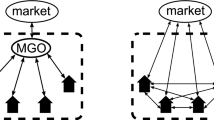Abstract
Purpose
Electricity flows are frequently used life cycle assessment modeling and are often a significant source of emissions so creating inventories based on detailed inventories, representative of regional differences in grid supplied power, is important. We sought to understand the influence electricity trades have on consumption mixes and developed a method for creating regionalized US electricity inventories based on publicly available data for electricity generation and trades.
Methods
With generation inventories for the eGRID subregions and trading within NERC regions, the trading operates within boundaries representative of distinct production regions while enabling trading. We created two approaches for allocating electricity trades within NERC regions, gross, and net trading. Trading is modeled using FERC data. Gross trading assumes that all trades within a NERC region contribute to each eGRID subregion receiving trades in to satisfy their demand while the net trading approach assumes that only eGRID subregions producing surplus electricity contribute to the mix in regions with deficits.
Results
We introduce the concept of trade pools for modeling electricity flows between individual eGRID subregions and the corresponding NERC regions. Challenges for modeling electricity trade flows are described in the Methodology section. We compare the results of the two trading approaches demonstrating the influence of prioritizing eGRID subregion generation mixes or trading within NERC regions. While trades represent a relatively small portion of total consumed electricity, some eGRID regions, like CAMX and those in New York state, rely heavily on trade to in order to meet their consumptive demand.
Conclusion
The method presented here establishes the basis for eGRID-level consumption mixes which account for energy trades and provide regionalized life cycle inventories for electricity in the USA. We provide recommendations for their use including in attributional LCA as well as approaches requiring marginal electricity demands. The trading approaches have been implemented in a US EPA repository to provide these inventories and can be found at https://github.com/USEPA/ElectricityLCI.








Similar content being viewed by others
References
Cer-rec.gc.ca. (2020) CER – Canada’s Energy Future 2016: Energy Supply and Demand Projections To 2040. Available at: http://www.cer-rec.gc.ca/nrg/ntgrtd/ftr/2016/index-eng.html. Accessed 10 August 2020
Colett JS, Kelly JC, Keoleian GA (2016) Using nested average electricity allocation protocols to characterize electrical grids in life cycle assessment. J Ind Ecol 20:29–41
FERC (2018) Form No. 714 - Annual Electric Balancing Authority Area and Planning Area Report. Federal Energy Regulatory Commission, Washington, DC. Available at: https://www.ferc.gov/industries-data/electric/general-information/electric-industry-forms/form-no-714-annual-electric/electronic. Accessed 10 August 2020
Holland SP, Mansur ET (2008) Is real-time pricing green? The environmental impacts of electricity demand variance. Rev Econ Stat 90:550–561
Johnson JX, Novacheck J (2015) Emissions reductions from expanding state-level renewable portfolio standards. Environ Sci Technol 49:5318–5325
Kim JD, Rahimi M (2014) Future energy loads for a large-scale adoption of electric vehicles in the city of Los Angeles: impacts on greenhouse gas (GHG) emissions. Energy Policy 73:620–630
Kodra E, Sheldon S, Dolen R, Zik O (2015) The North American electric grid as an exchange network: an approach for evaluating energy resource composition and greenhouse gas mitigation. Environ Sci Technol 49:13692–13698
Marriott J, Matthews HS (2005) Environmental effects of interstate power trading on electricity consumption mixes. Environ Sci Technol 39:8584–8590
Mutel CL, Pfister S, Hellweg S (2011) GIS-based regionalized life cycle assessment: how big is small enough? Methodology and case study of electricity generation. Environ Sci Technol 46:1096–1103
NERC (2020) Available at: https://www.nerc.com/Pages/default.aspx. Accessed 10 August 2020
Ryan NA, Johnson JX, Keoleian GA (2016) Comparative assessment of models and methods to calculate grid electricity emissions. Environ Sci Technol 50:8937–8953
Tamayao M-AM, Michalek JJ, HendricksonAzevedo, I.s.M., C (2015) Regional variability and uncertainty of electric vehicle life cycle CO2 emissions across the United States. Environ Sci Technol 49:8844–8855
The Emissions and Generation Resource Integrated Database (2018) Available at: https://www.epa.gov/sites/production/files/2020-01/documents/egrid2018_technical_support_document.pdf Accessed 10 August 2020
U.S. EPA. (2014) Tool for Reduction and Assessment of Chemicals and Other Environmental Impacts, version 2.1; Environmental Protection Agency
US Energy Information Administration (2016) US Mexico trade, 2016 Available at: https://www.eia.gov/todayinenergy/detail.php?id=11311. Accessed 10 August 2020
Weber CL, Jaramillo P, Marriott J, Samaras C (2010) Life cycle assessment and grid electricity: what do we know and what can we know? Environ Sci Technol 44:1895–1901
Author information
Authors and Affiliations
Corresponding author
Additional information
Communicated by Yi Yang.
Publisher’s Note
Springer Nature remains neutral with regard to jurisdictional claims in published maps and institutional affiliations.
Supplementary Information
Below is the link to the electronic supplementary material.
Rights and permissions
About this article
Cite this article
Hottle, T., Ghosh, T. Regional electricity consumption mixes using trade data for representative inventories. Int J Life Cycle Assess 26, 1211–1222 (2021). https://doi.org/10.1007/s11367-021-01876-3
Received:
Accepted:
Published:
Issue Date:
DOI: https://doi.org/10.1007/s11367-021-01876-3




